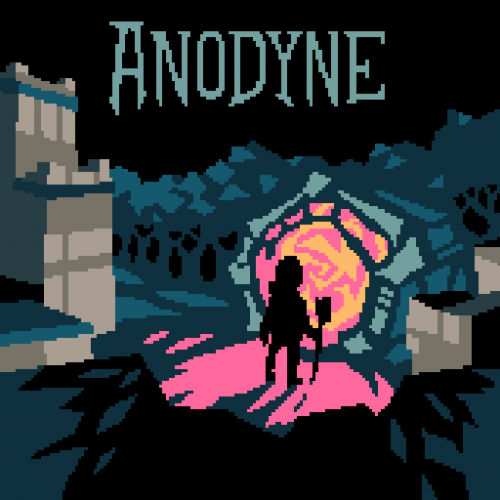

Indie video games often fall into roughly two categories: those that experiment with a novel core game mechanic and those that pay homage to tried-and-true tropes of classic gaming while turning them on their head. Recently released and catching my attention, Anodyne, a top-down Legend of Zelda-inspired adventure game, resides firmly within the latter category. I felt like I was taking a (tiny) chance buying this little indie game I’d yet to hear anything about, but I trusted the retro 16-bit surreal art style to deliver, at the very least, a quirky distraction. Had I done my homework, I’d have found that the developers, a two-man team of Sean Hogan and Jonathan Kittaka, crafted a cleverly designed and dreamily rendered tribute to a classic series.
Anodyne wears its gratitude to early 2D Legend of Zelda titles on its sleeve. The styling of the sprites exudes the charm of those classic games — characters are colorful with squat proportions, grass blows and water flows in a rhythmic pattern and pixelated landscapes, such as meadows, towns, deserts, beaches and graveyards, are peppered with detail to endow them with some depth. Even the ways that the characters walk and the enemies shimmy, crawl and leap feels familiar. At the same time, the tone of this world is just a shade darker, more desolate, dreamy and surreal compared to that of Legend of Zelda. Some of the landscapes are truly bizarre, such as a red forest of dead trees at the bottom of a whirlpool, inhabited by looming bipedal and amorphous creatures. Even more mundane locales have strange little details that make you question the game (or its developers), such as a lobster on a beach that loves to watch the ocean or a rhyming troll who is sworn to protect bees. As the game went on, I felt as if I was exploring a certain take on Wonderland.
Exploration is the name of the game in Anodyne. The homage to the Legend of Zelda is even more obvious in the gameplay than the art style. Armed with only a broom (seriously), you must explore the unnamed world in order to save it. Of course, it starts out simple enough, as your path is straightforward and enemies don’t really want to fight you. Eventually you have to solve puzzles by killing enemies, pressing switches and placing dust clouds with your broom. After you get through an introductory dungeon, however, you are thrust into a meadow and given no direction. From here on, the game refuses to hold your hand. Exploration is the key to advancement, yielding keys and new items. It takes some time to explore the large environments, especially because you walk rather slowly (I wish running were an option) and some enemies reappear when you leave an area. At certain points I found myself walking in circles wondering what to do. Yet eventually I’d always find the trick that let me advance a little farther, and that was immensely gratifying each time. The tension and release of disorientation and realization is the game’s most potent and satisfying quality, one that keeps me playing in spite of any momentary frustration. In addition to advancing the gameplay, exploration slowly uncovers the game’s strange and scattered narrative.
The game begins with our protagonist, a bespectacled young man named “Young,” talking to a sagely sage aptly named “Sage.” Sage informs Young that he must find an elder named “The Briar” in order to stop “The Darkness” from taking over “The Land.” At first the story didn’t feel like much of one; indeed, I thought this comically generic exchange to be merely a jab at typical video game exposition. Yet the narrative is revealed very slowly, bit-by-bit, as you read signs and meet people over the course of the game. It can be difficult to piece the entire story together, especially since you’re never quite sure if there are gaps in your knowledge. Over time you find that the world of Anodyne is as surreal as it looks, for reasons I’d rather not spoil, though I can guarantee that there is actually a satisfying (though rather dark) explanation for the seemingly generic story. Even without the context of the story, there’s a palpable loneliness in Young’s journey. You spend a lot of time reading signs and words carved into boulders. Encounters with fellow human beings are uncommon, while the occasional talking animal tends to wax philosophical rather than give you advice or help you in your quest. I found that this desolate atmosphere implied a narrative all its own, even without the addition of dialogue and text. The soundtrack to the game is similarly moody and ethereal, even beautiful at times. Each unique locale has its own music, yet it’s never steeped with tired musical clichés in an attempt to match the environment. Seriously, I advise fellow music majors to give one or two tracks a listen.
Anodyne takes roughly eight hours to complete, so it’s a relatively quick distraction. For the price ($10 MSRP), buying this game was a no-brainer. For fans of classic adventure games, this game will bring back memories of those you played years ago and its strange twists on the familiar 16-bit style and an equally offbeat story will mess with your head.
Hey, I'm Sean - one of the devs - thanks for posting about this, it's very thoughtful! Glad you like the music I wrote, too. :) On an amusing note, my school (UChicago) still hasn't made a peep about Anodyne in their larger student-run newspaper!
Take care!